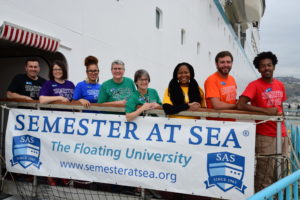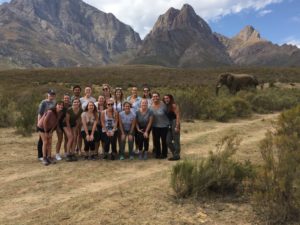Part one of a four-part series on Semester at Sea and Colorado State University
In this four-part series, we invite you to explore the experience of Semester at Sea through the eyes of School of Education faculty member and Assistant Vice President for Student Affairs Jody Donovan, who served as dean of student life during the SAS spring 2017 voyage. Part one offers an overview of Semester at Sea; part two explores life onboard the ship and the countries visited during the spring 2017 voyage. Part three will delve into Donovan’s experiences during the semester, and part four concludes the series with reflections on CSU’s first year as Semester at Sea’s partner and future hopes.
CSU and SAS: a brief history

Jody Donovan became involved in a bid to bring Semester at Sea to Colorado State University in spring 2015.
“I felt strongly that we should actively work to make sure that SAS was aligned with CSU’s values of inclusion, access, learning, and service if we became the new partner institution,” she recalls. “The proposal was written with this in mind, emphasizing what CSU does well and highlighting these values. We ended up being one of SAS’s three finalists; when the Institute for Shipboard Education [a private, nonprofit, educational corporation that administers the SAS global study abroad program] visited CSU, it was obvious the CSU community would embrace and be involved with SAS.”
True to this commitment, the formal CSU/ISE agreement calls for a CSU academic dean and four faculty (known as “global teaching scholars”) to sail on each voyage. Additionally, CSU candidates have preferred consideration for several SAS staff positions, including academic adviser/registrar, librarian, a student life team position, and two health team positions.
The remaining staff and faculty come from institutions all over the world. In addition, CSU partnered with ISE to align the SAS code of conduct with CSU’s Conduct Code and Principles of Community, an alignment that Donovan said helps reaffirm the position of SAS as a deep global learning experience.
The University and SAS are committed to helping CSU first-generation and students of limited income participate in SAS, offering scholarship and funding opportunities that make the voyage possible for some students who might not otherwise be able to participate. SAS provides funding to the Office of International Programs to award to eligible CSU students.
During the spring 2017 semester, Donovan served as the dean of student life for CSU’s second SAS voyage. For 105 days, Donovan and the rest of the “staculty” – a term coined by the previous semester’s administrative team, which included CSU’s Human Development and Family Studies professor Toni Zimmerman, who served as Academic Dean, as well as Associate Dean of Students Craig Chesson and Senior Associate Director Registrar D. Tobiassen Baitinger, to emphasize that all SAS faculty and staff are educators while on the ship – worked together to educate and support nearly 600 students from institutions all over the world.
About SAS students and staculty

Students on-board are a microcosm of undergraduate students on the CSU campus. They range from gap-year students – those who have just graduated from high school and are preparing for their freshman year at a university – through post-bachelor students – those who have graduated from a university within the past year.
“We had 17 year old students on this voyage, all the way up to military veterans who are in their 30s and are working toward an undergraduate degree,” said Donovan. “We had students who had never been away from home, and students who had lived internationally.”
SAS students come from institutions worldwide. In fact, 40 students joined SAS from the Davis United World College Scholars Program, exceptional young people who have graduated from a UWC school and then matriculated at selected U.S. colleges or universities. These students, Donovan reflected, were academically well-prepared and very aware politically, having lived and traveled internationally and independently.
“They loved engaging with U.S. students and learning about university life in the U.S. Many plan to attend an institution in the U.S. after they graduate.”
Once accepted to SAS, non-CSU students become non-matriculated “guest” students of CSU for the semester. To ensure the SAS experience doesn’t interrupt pursuit of degrees, the courses offered during SAS are transferrable, and represent nearly every discipline, including history, business, English, economics, natural resources, education, tourism, psychology, and science.
The staculty come from all over the world as well, applying 18 months-to-three years in advance of sailing for SAS teaching and staff positions. Faculty are hired to teach courses in the CSU course catalog; their credentials and course syllabi are reviewed by the appropriate CSU department to ensure the course reflects the academic quality and rigor of CSU. In addition to in-classroom content design, SAS faculty create in-country field classes or experiences that align with and enhance the course content. Student life staff also apply one-to-two years in advance of sailing. Prior to sailing, the Student Life staff prepare the out-of-class learning and involvement opportunities on the ship.
Stay tuned for more of this series. To see Donovan’s SAS photos, visit the album on Flickr.
The School of Education is part of CSU’s College of Health and Human Sciences.